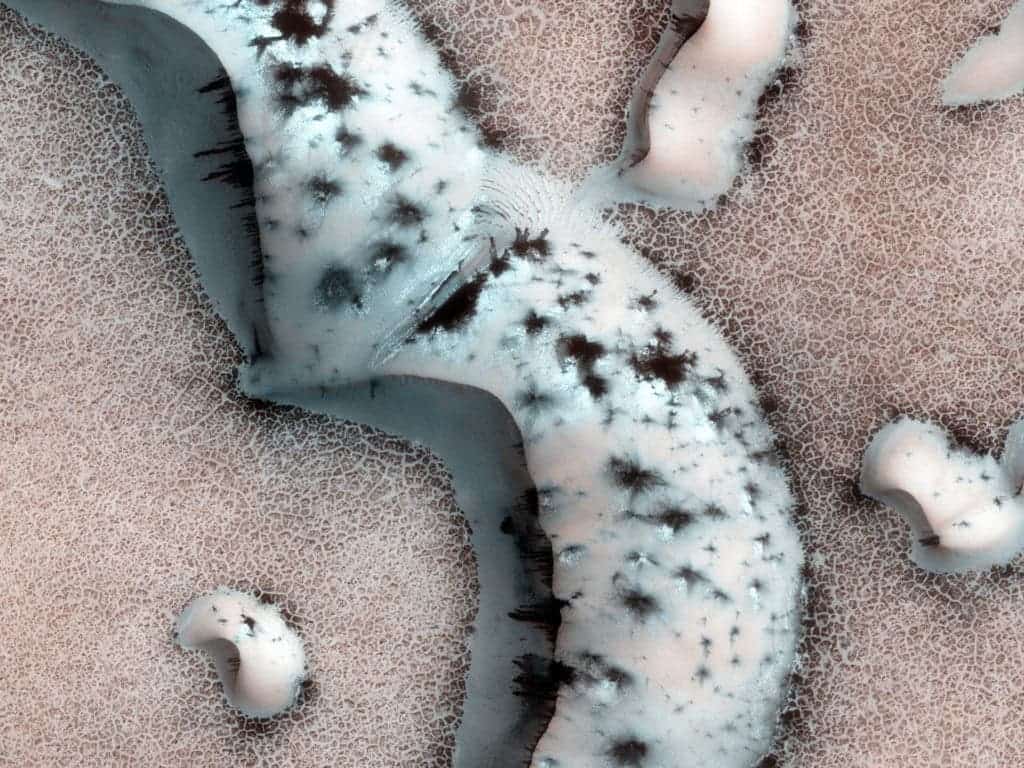
There’s a lot of talk about putting boots on Mars but hype aside here’s one important thing that this conversation is often missing: Mars is extremely inhospitable.
The atmosphere is thin and unbreathable and the temperature on Mars can get down to nearly minus 200 degrees Fahrenheit (-128°C). In order to make the planet more bearable, some have even proposed extreme solutions such as terraforming Mars. However, there are more realistic solutions. Recently, a group of scientists has proposed using an insulating material called silica aerogel — often called “frozen smoke” due to its appearance — like a blanket to warm plant life growing beneath it.
Building a tiny Earth underneath a dome
Silica aerogel is the most common and most studied form of aerogel. It’s lighter than air and is transparent enough to let visible light pass through while blocking harmful ultraviolet rays. In a new study, researchers at the Harvard University, NASA’s Jet Propulsion Lab, and the University of Edinburgh investigated whether a thin layer of silica aerogel could be used to mimic Earth’s greenhouse effect.
The research team simulated the Martian environment in a lab. They simulated light hitting the surface in Mars-like conditions and used a layer of silica approximately 3 cm thick as an insulator.
The researchers then measured the temperature and the amount of UV radiation that passed through the aerogel layer, with very promising results. The temperature difference between the top and bottom layer was more than 50 degrees Celsius (90 degrees Fahrenheit). Raising the temperature permanently above the melting point of water and filtering ultraviolet radiation are essential properties required for plant life — and the aerogel can achieve both, all without the need for any internal heat source.
“This regional approach to making Mars habitable is much more achievable than global atmospheric modification,” said Robin Wordsworth, Assistant Professor at the Harvard John A. Paulson School of Engineering and Applied Sciences (SEAS). “Unlike the previous ideas to make Mars habitable, this is something that can be developed and tested systematically with materials and technology we already have.”
“Mars is the most habitable planet in our Solar System besides Earth,” said Laura Kerber, Research Scientist at NASA’s Jet Propulsion Laboratory. “But it remains a hostile world for many kinds of life. A system for creating small islands of habitability would allow us to transform Mars in a controlled and scalable way.”
The researchers sought inspiration in the Martian polar ice caps. Unlike those on Earth, which are made of frozen water, the Martian polar ice caps are made of frozen water and frozen CO2. The interesting thing about frozen CO2 is that it allows sunlight to pass through while trapping heat, creating a sort of greenhouse effect during the summer, allowing warm pockets to form. Silica aerogel is a lot like frozen CO2 since it allows light to move through the material while trapping infrared radiation in its interconnecting nanolayers of silicon dioxide. Its excellent thermal insulating properties are the reason why aerogels are widely used in many space applications, including NASA’s Mars Exploration Rovers.

By combining their experiments’ results with modeling, the researchers concluded in the journal Nature Astronomy that a thin layer of this material could be used to envelop a small area of mid-latitude Mars to achieve Earth-like temperatures.
“Spread across a large enough area, you wouldn’t need any other technology or physics, you would just need a layer of this stuff on the surface and underneath you would have permanent liquid water,” said Wordsworth.
So, rather than terraforming an entire planet — something which is physically impossible with today’s technology — this approach essentially involves terraforming just a small, manageable patch of Mars. The researchers envision a huge habitation dome built out of silica aerogel, where plants could grow underneath.
Of course, there are still many engineering challenges that need to be addressed. The aerogel dome wouldn’t be able to raise the atmospheric pressure, which right now hovers at around a pitiful six millibars — tiny compared to the one bar at sea level on Earth. According to a study previously reported by Bruce Jakosky at the University of Colorado, Boulder, and Christopher Edwards at Northern Arizona University, we would need something like a million ice cubes of carbon dioxide ice that are a kilometer across in order to do get to one bar. However, there’s only enough carbon dioxide in the Martian polar ice caps, dust and rocks to raise the pressure to 20 millibars at most. Martian storms, such as the one that shut down the Opportunity Rover last year, can also be very intense and strong. It would be not easy to make an aerogel dome that could brave Martian sand storms.
Wordsworth also points out that there are ethical considerations when building habitats on Mars.
“If you’re going to enable life on the Martian surface, are you sure that there’s not life there already? If there is, how do we navigate that,” asked Wordsworth. “The moment we decide to commit to having humans on Mars, these questions are inevitable.”






